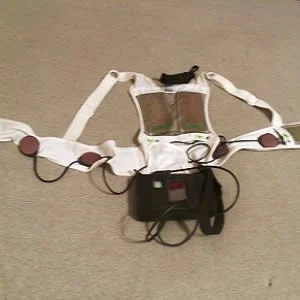Sudden cardiac death (SCD) – including out-of-hospital cardiac arrests – is responsible for over 300,000 deaths in the U.S. yearly. In 2002, the wearable cardioverter defibrillator (WCD) gained FDA approval for its efficacy in the prevention of sudden cardiac arrest or death in certain at-risk populations. Despite the prevalence of SCD and the demonstrated efficacy of the WCD, this technology remains underprescribed, according to a review to appear in the journal Current Problems in Cardiology.
Sudden cardiac arrest is the event that occurs when an abnormal cardiac rhythm causes haemodynamic instability and subsequent collapse in the absence of normal breathing and signs of circulation. It often leads to SCD, which usually occurs within one hour of symptom onset (if witnessed) or within 24 hours of the last known time a patient was alive (if unwitnessed). Annually in the United States, SCD comprises 40-50 percent of total mortality rates from cardiovascular disease.
Patients with the highest risk of SCD are those with ischaemic and nonischaemic cardiomyopathy who have a reduced left ventricular ejection fraction (≤ 35-40%). Risk factors for ischaemic heart disease and SCD are similar and include smoking, hypertension, dyslipidaemia, and diabetes.
"The wearable cardioverter defibrillator has emerged as an important, noninvasive tool to combat sudden cardiac death in high-risk patients who are not candidates for implantable cardioverter defibrillators," the journal article notes. "Despite gaining FDA approval in 2002 and making its way into national guidelines in both Europe and the United States, the device remains underprescribed and, thus, underutilised clinically."
Currently, the LifeVest® (ZOLL Lifecor Corp., Pittsburgh, PA, USA) is the only WCD manufactured. It acts as a continuous heart-rhythm monitor and is capable of producing up to five biphasic shocks at a maximum of 150 Joules each when ventricular fibrillation (VF) or ventricular tachycardia (VT) are detected. The two components of the device are the vest itself, which has electrodes embedded within the fabric, and a defibrillation unit that is carried separately. An added safety feature of the LifeVest® are two buttons that, when pressed simultaneously, can abort the defibrillation sequence in conscious patients.
WCDs have gradually become part of major guidelines, including those disseminated by the European Society of Cardiology and the American Heart Association, American College of Cardiology, and Heart Rhythm Society’s combined guidelines. The 2016 ESC Guidelines find WCDs potentially able to assess one’s ventricular rate “during rest, exercise, and sleep,” but the value of this monitoring is yet to be established. Despite being able to assess heart rate and rhythm, the WCD lacks the ability to pace should a patient develop a bradyarrhythmia.
Moreover, the 2017 ACC/AHA/HRS Guidelines note many potential uses for WCDs that are yet to become guideline-based indications for therapy. For example, WCDs may provide protection in patients who have been resuscitated from a sudden cardiac arrest event due to coronary spasm but have yet to be optimised on medical therapy or in whom medical therapy is ineffective.
However, as of 2012 (or 10 years after the LifeVest® entered the market), only 60,000 devices had been prescribed worldwide. More recent data on prescribing practices has not been made available. Unless annual prescription in the U.S. alone has grown to over 300,000, to equate the number of SCDs annually, this discrepancy highlights the underutilisation of this device, according to the journal article.
In the review article, Pooja S. Jagadish, MD, of the Department of Internal Medicine, University of Tennessee Health Science Center, and co-authors highlight the potential causes for underutilisation of the WCD. Among these reasons include confusion about the guidelines and when to prescribe, who can prescribe the device, and debate about whether the WCD is efficacious based on recent studies.
Other social barriers to prescription include cost and adherence to therapy by the patient. One daunting issue is that of false alarms and inappropriate shocks, the authors note.
"There appear to be multiple problems with education about the WCD and numerous social barriers to overcome; these issues prevent the device from fulfilling its true purpose. Ultimately, by improving prescriber education about the wearable cardioverter defibrillator and addressing factors such as cost, comfort, and transparency of data, the decision to prescribe will be more squarely placed in providers’ hands with the potential of positively impacting patient lives," write Dr. Jagadish and co-authors. They also say future studies should focus on assessing the true reasons for underprescription and assessing how incorporating WCDs into a heart failure order set could improve rates of device administration.
Source: Current Problems in Cardiology
Image Credit:Tony the Marine (talk) via Wikimedia Commons
References:
Jagadish PS, Aziz M, Chinta V, Khouzam RN (2018) Misunderstood or Mistrusted? The Under-Utilization of the Wearable Cardioverter Defibrillator in Clinical Practice. Curr Probl Cardiol. Article in Press, Available online 18 September 2018. https://doi.org/10.1016/j.cpcardiol.2018.09.002
Latest Articles
SCD, sudden cardiac death, wearable cardioverter defibrillators, WCD
Sudden cardiac death (SCD) – including out-of-hospital cardiac arrests – is responsible for over 300,000 deaths in the U.S. yearly. In 2002, the wearable cardioverter defibrillator (WCD) gained FDA approval for its efficacy in the prevention of sudden car










